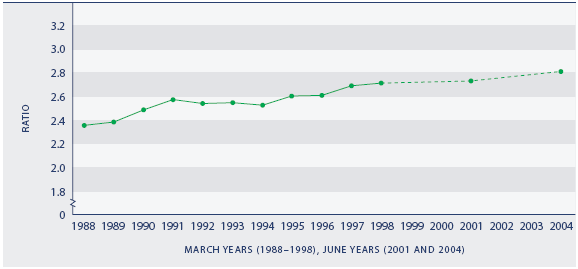Income inequality
Definition
The extent of disparity between high and low incomes.
The measure used here is the ratio of the 80th percentile to the 20th percentile of the equivalised household disposable income distribution (ie the ratio of a high household income to a low household income, after adjustment for household size and composition). The higher this ratio, the greater the level of inequality.
Relevance
The degree of income inequality is often regarded as an important aspect of the fairness of the society we live in. A high level of income inequality may also be detrimental to the level of social connectedness across society.
Current level and trends
In 2004, the equivalised disposable income of a household at the 80th percentile was 2.8 times larger than the income of a household at the 20th percentile, a slight increase from 2.7 times larger in 2001. In 1988, the ratio was 2.4. Income inequality rose between 1988 and 1991, then plateaued, rising again from 1994.
Most of the observed increase in income inequality was due to a larger overall rise in incomes for those in the top 20 percent of incomes than for those in the bottom 20 percent of incomes. Between 1988 and 2004, incomes of those in the bottom 20 percent of all incomes increased only a little, once adjustments for inflation are made, whereas those in the top 20 percent of incomes climbed by more than a third. Incomes for the middle 60 percent climbed more overall for those closer to the top 20 percent than for those closer to the bottom 20 percent.
Between 1998 and 2001, changes in average incomes were uniformly low for all income groups. Between 2001 and 2004, average incomes grew most for those with incomes in the middle 60 percent and less for those with incomes in the top 20 percent after inflation is taken into account. On average, there was relatively little change for those with incomes in the lowest 20 percent after adjusting for inflation. Year to year changes for these figures need to be treated with caution because many of the changes may be within the margin of error for their estimates.
Figure EC2.1 Ratio of the 80th percentile of equivalised disposable household income to the 20th percentile of equivalised disposable household income, 1988–1998, 2001 and 2004

Source: Derived from Statistics New Zealand's Household Economic Survey (1988–2004), by the Ministry of Social Development
Notes: (1) Since 1998, the Household Economic Survey has been conducted on a three-yearly basis, rather than annually (2) This measure adjusts for household size and composition
International comparison
Comparisons with other OECD countries are available using a different measure, the Gini coefficient.55 Gini coefficients measure income inequality, with a score of 100 indicating perfect inequality and a score of 0 indicating perfect equality. Around the year 2000, New Zealand's score of 33.9 indicated higher inequality than the OECD median (30.1) and a ranking of 18th out of 25 countries. Northern European countries had the least income inequality, with Denmark having the lowest Gini coefficient of 22.5. New Zealand's score was slightly higher than those for Canada (30.1), Australia (30.5) and the United Kingdom (32.6), and lower than that for the United States (35.7).56 The 2004 figure for New Zealand was 33.5.
|

